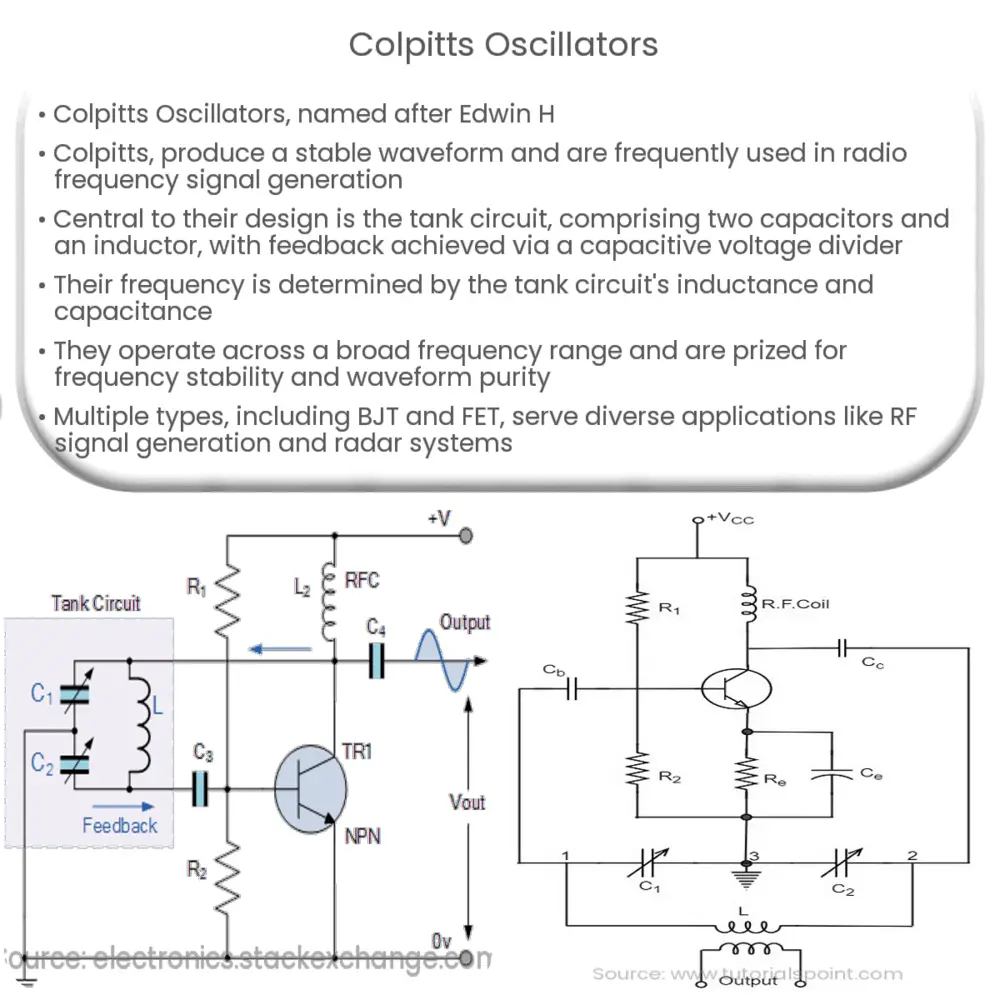Explore the fundamentals, types, advantages, and applications of Colpitts Oscillators, a crucial component in modern electronics.

Introduction to Colpitts Oscillators
Commonly utilized in the field of electronics, Colpitts Oscillators play a crucial role. Named after their inventor, Edwin H. Colpitts, these oscillators are valued for their ability to produce a stable, continuous waveform output. Often, they are used in the generation of radio frequency signals.
Construction and Working Principle
The heart of a Colpitts oscillator is its tank circuit. This tank circuit is a parallel combination of two capacitors and an inductor. These elements store and exchange energy, thus generating the oscillation. The key aspect of the Colpitts oscillator’s design is that the feedback necessary for operation is achieved through the capacitive voltage divider network.
Design Features of Colpitts Oscillators
-
The frequency of oscillation is primarily determined by the tank circuit’s inductance (L) and the combined capacitance (C) of the two capacitors in the circuit.
-
Colpitts oscillators can operate over a wide range of frequencies, from a few kilohertz to hundreds of gigahertz.
-
Compared to other types of oscillators, Colpitts oscillators provide better frequency stability and waveform purity.
Types of Colpitts Oscillators
-
Bipolar Junction Transistor (BJT) Colpitts Oscillator: This type uses a BJT (Bipolar Junction Transistor) as the active element.
-
Field-Effect Transistor (FET) Colpitts Oscillator: Here, a FET (Field Effect Transistor) is the active element. This type is particularly beneficial due to the high input impedance and low output impedance of FETs.
In conclusion, Colpitts oscillators are an essential part of modern electronics, thanks to their ability to generate a consistent and reliable oscillatory output. They come in a variety of forms, each with its advantages, and are adaptable to a broad range of applications.
Applications of Colpitts Oscillators
Thanks to their robustness and versatility, Colpitts Oscillators find widespread application in a variety of fields:
-
They are used in RF signal generation in radio and television transmitters.
-
They serve as the local oscillator in superheterodyne receivers, an essential component in tuning radio stations.
-
Colpitts oscillators are also found in radar systems, and other electronic devices requiring a stable frequency source.
-
They also find use in communication systems and medical equipment.
Advantages and Disadvantages of Colpitts Oscillators
Like any other system, Colpitts oscillators have both benefits and drawbacks.
Advantages
-
Colpitts oscillators generate a very pure waveform, with low harmonic distortion.
-
They have a broad frequency range – from a few kilohertz to hundreds of gigahertz.
-
The oscillator provides excellent frequency stability, meaning it is less likely to deviate from its set frequency.
Disadvantages
-
The start-up conditions for a Colpitts oscillator can be difficult to achieve, requiring delicate tuning of component values.
-
They can have higher power consumption compared to other types of oscillators.
Conclusion
In the end, the choice of oscillator technology comes down to the specific needs of the application. Colpitts oscillators, with their broad frequency range, excellent frequency stability, and pure waveform, are a popular choice for many applications. Despite some challenges in start-up conditions and potential power consumption, their advantages often outweigh the drawbacks, making them a staple in electronics. Whether in radios, medical devices, or radar systems, Colpitts oscillators continue to be a pivotal part of our technological landscape.
